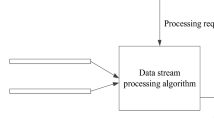Abstract
In allusion to the widespread anomalous data in substation primary equipment condition monitoring, this paper proposes an OPTICS (Ordering Points To Identify the Clustering Structure) clustering-based condition monitoring anomalous data filtering algorithm. Through the characteristic analysis of historical primary equipment condition monitoring data, an anomalous data filtering mechanism was built based on density clustering. The effectiveness of detecting anomalous data was verified through the experiments on one 110 kV substation equipment transformer oil chromatography and the GIS (Gas Insulated Substation) SF6 density micro water. Compared with traditional anomalous data detection algorithms, the OPTICS Clustering-based algorithm has shown significant performance in identifying the features of anomalous data as well as filtering condition monitoring anomalous data. Noises were reduced effectively and the overall reliability of condition monitoring data was also improved.
Access this chapter
Tax calculation will be finalised at checkout
Purchases are for personal use only
Similar content being viewed by others
References
Production and Technology Department of State Grid Q/GDW169-2008 Guide for condition evaluation of oil-immersed power transformers(reactors). China Electric Power Press, Beijing (2008) (in Chinese)
State Economic and Trade Commission DL/T722—2000 Guide to the analysis and the diagnosis of gases dissolved in transformer oil. China Electric Power Press, Beijing (2001) (in Chinese)
Ester, M., Kriegel, H.-P., Sander, J., Xu, X.: A density-based algorithm for discovering clusters in large spatial databases with noise. In: Simoudis, E., Han, J., Fayyad, U.M. (eds.). Proceedings of the Second International Conference on Knowledge Discovery and Data Mining (KDD-1996), pp. 226–231. AAAI Press (1996). ISBN 1-57735-004-9
Zhang, S.-Z., Yao, J.-Q.: Research on abnormal condition monitoring data filtering and alarm mechanism. Electr. Power Inf. Commun. Technol. (1) (2013)
Y-Q, C., K-P, L.: A condition monitoring method of generators based on RBF dynamic threshold model. Proc. CSEE 27(26), 96–101 (2007)
Li, J.-L., Zhou, L.-K.: Detecting and identifying gross errors based on “3σ Rule”. Comput. Modernization 1, 10–13 (2012)
Osorio, F., Paula, G.A., Galea, M.: On estimation and influence diagnostics for the Grubbs’ model under heavy-tailed distributions. J. Comput. Stat. Data Anal. 53, 1249–1263 (2009)
McDaniel, W.C., Dixon, W.J., Walls, J.T.: Examination of Dixon’s up and down method for small samples in the estimation of the ED50 for defibrillation. In: Engineering in Medicine and Biology Society, Proceedings of the Annual International Conference of the IEEE, vol. 13, pp. 760–761. IEEE (1991)
Zhang, X., Chen, M., Xiao F.: Origin used in comparison the methods of eliminating the excrescent data. Exp. Sci. Technol. (1), 74–76 (2012)
Zhang, W., Liu, C., Li, F.: Method of quality evaluation for clustering. Comput. Eng. 31(20), 10–12 (2005)
Zhuang, J., Ke, M., Qin, W.: Research on SF6 gas density and moisture online monitoring for high-voltage apparatus. Computer Measurement & Control (2013)
Mihael, A., Markus, M.B., Hans-Peter, K., Jörg, S.: OPTICS: ordering points to identify the clustering structure. In: ACM SIGMOD International Conference on Management of Data, pp. 49–60. ACM Press (1999)
Author information
Authors and Affiliations
Corresponding author
Editor information
Editors and Affiliations
Rights and permissions
Copyright information
© 2015 Springer International Publishing Switzerland
About this paper
Cite this paper
Zhang, Q., Wang, X., Wang, X. (2015). An OPTICS Clustering-Based Anomalous Data Filtering Algorithm for Condition Monitoring of Power Equipment. In: Woon, W., Aung, Z., Madnick, S. (eds) Data Analytics for Renewable Energy Integration. DARE 2015. Lecture Notes in Computer Science(), vol 9518. Springer, Cham. https://doi.org/10.1007/978-3-319-27430-0_9
Download citation
DOI: https://doi.org/10.1007/978-3-319-27430-0_9
Published:
Publisher Name: Springer, Cham
Print ISBN: 978-3-319-27429-4
Online ISBN: 978-3-319-27430-0
eBook Packages: Computer ScienceComputer Science (R0)




